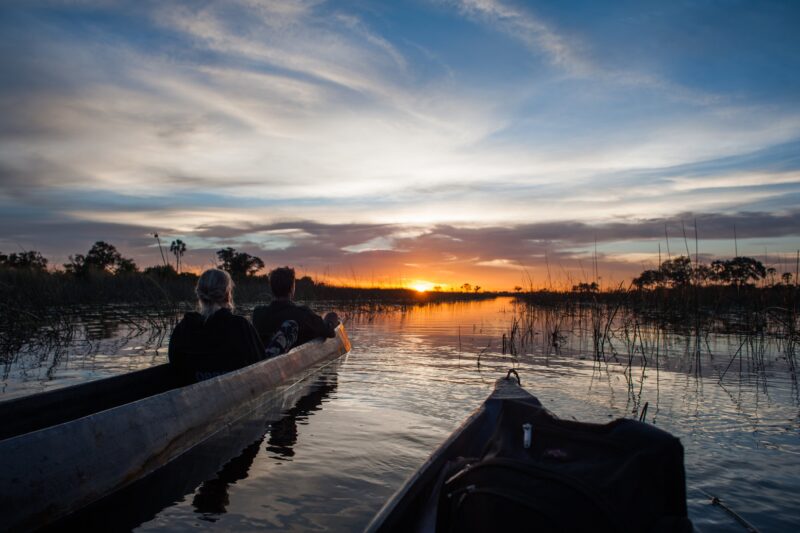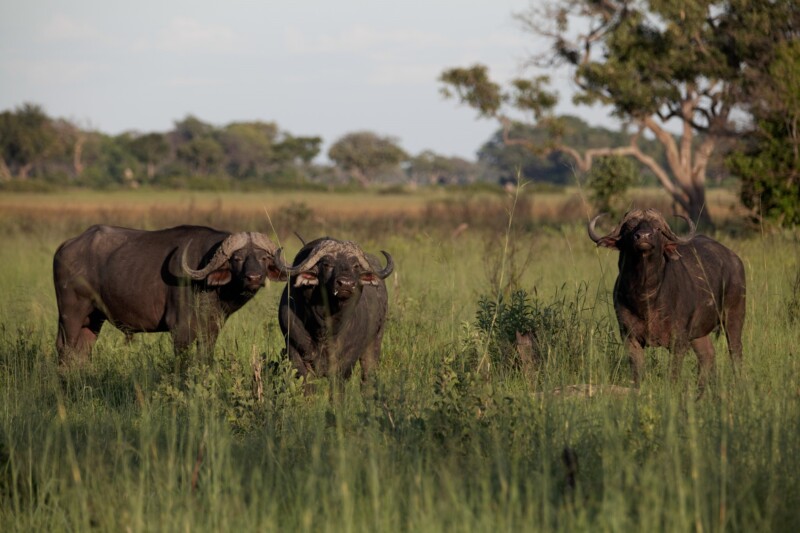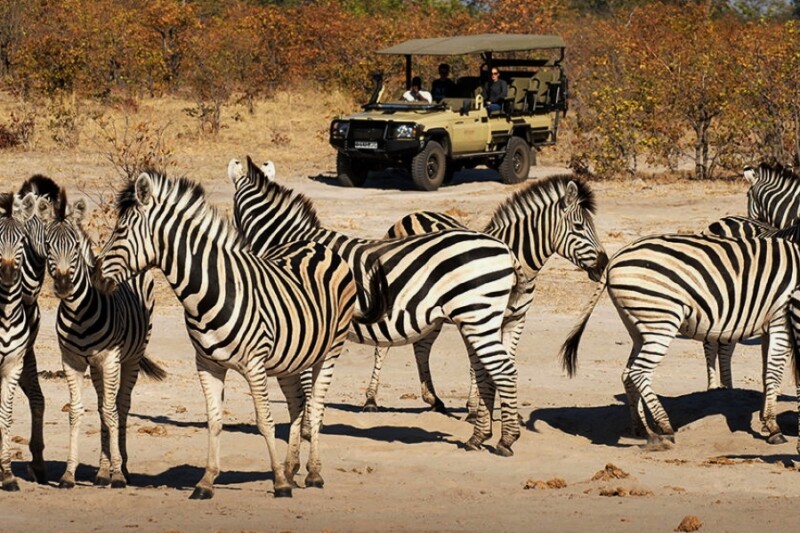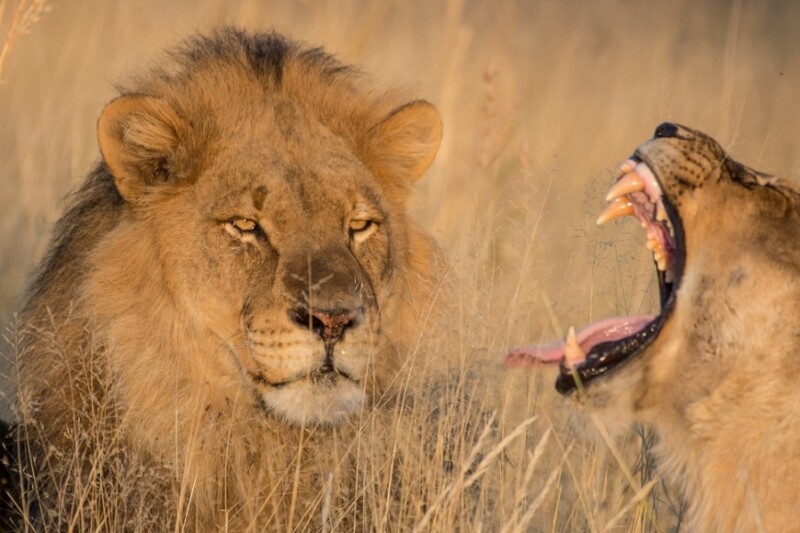Botswana is a small country with vivid lifestyles. Though the population of the country is sparse, you will be amazed to reach a warm welcome in this part of the African continent. Major parts of Botswana are semi-desert giving you many great opportunities to feel different. In Botswana, you can find some of the best game parks and nature reserves in the world. The Okavango Delta is a mosaic of lagoons, woodland, islands, waterways, and one of the world’s most incredible wildlife sanctuaries. Explore the famous Selinda Concession, Moremi Game Reserve, and Khwai Concession – which offers superb sceneries and true wilderness experience.
Spectacular sunsets, different wildlife experiences, Night drives and walking safaris – best Botswana trips, tours and safari packages – Okavango Delta, Makgadikgadi Pans and Central Kalahari; Moremi Game Reserve, one of the best wildlife areas of Botswana which covers swamp and dry areas. Start planning your Safari of a lifetime.
Botswana is Calling
We select lodges, hotels and other, which combine good facilities with character and good service, and, most importantly, are within easy reach of the best wildlife areas. Scheduled charter flight transfers from establishments are offered, activities include day and night game drives in open 4×4 vehicles, as well as a mokoro trip to explore the waterways of the Okavango Delta. We pride ourselves on our ability to tailor a truly unique journey that immerses you in some of the planet’s most spectacular places.

Okavango Delta
The best known of Botswana’s wildlife areas, the Okavango Delta is one of the most sought after wilderness destinations in the world. The 1,000th UNESCO World Heritage Site is the Africa of safari dreams; big game viewing, tranquillity and serenity and extraordinary natural beauty.
The Okavango Delta’s existence is remarkable; starting each year with rains in the Angolan highlands, the waters travel across the Caprivi Strip and spill into the fan-shaped delta in the north-west of the country, an almost 2,000 kilometre journey spanning more than six months. By the time the journey ends near Maun, in the delta’s southern fringes, over 95% of the water has been lost due to evaporation.
The channels, rivers, lakes and islands that form the delta provide amazing wildlife viewing, by land and by water. Whether game viewing from a safari vehicle, a cruise boat or a traditional mokoro, the sheer diversity and number of animals in staggering. At last count, the Okavango was home to 122 species of mammals, 71 species of fish, 444 species of birds, 64 species of reptiles and 1300 species of flowering plants. Not only will you spot elephant, lion, buffalo, giraffe, zebra, hippo and so much more; a successful reintroduction program has seen the number of black and white rhino increase.
Explore Botswana’s untouched natural wonders and thrill to intimate wildlife encounters at luxuriously rustic lodges and camps on the Okavango Delta and the Chobe National Park.

Savute – Linyanti – Chobe National Park
A remote and wild corner of Chobe National Park, Savute stretches from the park’s northern boundaries to the Linyanti River. The area’s main feature is the mysterious Savute Channel, which flows and dries up seemingly unrelated to the rainfall. Dry and arid for almost 30 years, animals in the area were sustained by artificial waterholes. With the Savute Channel flowing again in recent years, the region has undergone a startling transformation, reverting to its natural lush and marshy state. Large numbers of wildlife have been attracted to this rejuvenated wilderness haven.
The Linyanti River (which is later named the Chobe River), forms a natural border between Namibia and Botswana. The Linyanti is divided into three private concessions -Linyanti, Selinda, and Kwando – making up an enormous wildlife-rich area shared between a few small camps and creating a remote and exclusive safari experience in an environment which offers a wonderful contrast to the floodplains of the Okavango.
One of the remotest and most inaccessible parts of Africa, the private reserve may be called a hidden paradise for safari enthusiasts. It offers more remote, private safari opportunities than the national parks allow, with walking and night drives, as well as off-road driving. Shared by a very small number of private camps, the enormous reserve is one of the least visited in Botswana, and ensures a very private and exclusive experience for those aiming to view abundant wildlife in a privileged context.
Sizable numbers of elephant bulls are invariably present. During the dry years, when prey was hard to find, many of Savute’s lion became notorious for hunting elephant. With the recent transformation of the region, prey has become more abundant and the large lion prides have split up into smaller family groups, allowing a greater variety of predators to flourish in the area. Savute is also a famous battleground for lion and spotted hyena. With grazing now plentiful, the area is also popular with zebra, wildebeest, buffalo, giraffe, tsessebe and kudu.
The birds of Savute are an attraction all by themselves. The largest flying birds, kori bustards prey on snakes and rodents found amongst the grass. Other birding attractions include the endangered ground hornbill, which can be seen meandering through the grasslands. Raptors are ever-present, including the bateleur eagle. Pin tailed whydahs glide across the grass in awkward swoops. Korhan’s give out their mating cries while flipping themselves into the air to attract attention from a potential mate.
During the rainy season, Savute hosts an annual zebra migration, which peaks in January and February, when the zebra congregate to graze on the sweet grasses brought on by the rains.
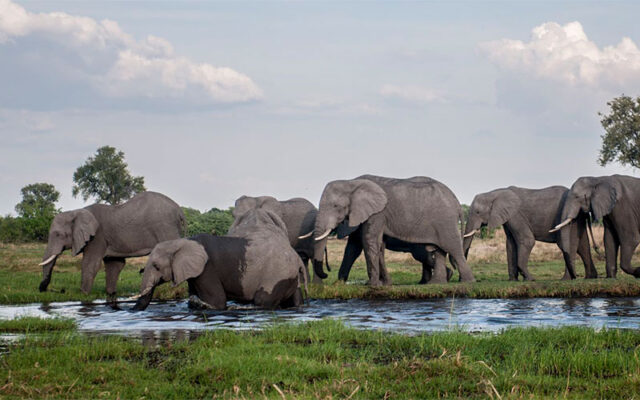
Chobe National Park
Proclaimed in 1968, Chobe National Parks receives its name from the Chobe River, a strip of brilliant blue winding through the landscape, which forms the northern border of the park. The river is also the border between Botswana and Namibia. Chobe is the third largest national park in Botswana after the Central Kalahari and Kgalagadi and is a photographer’s dream. The combination of the floodplains and the river provide a sensitive ecosystem where the wildlife congregates along waterways during the dry season.
Chobe is famous for its spectacular elephant sightings. With a population of around 70,000, Chobe has one of the highest concentrations of elephants in Africa. In this park, you can get so close to them you can feel the rumble as they communicate with each other.
Vast endless landscapes, open plains, baobab trees and the ancient woodland dominate the panorama. In the dry season, the elephants assemble in the Chobe River,the herds migrate from south to north and congregate along the perennial Chobe River and fertile floodplains.
Once the rains come, they start their approx. 200 kilometre migration to the southern parts of the park. It is home to elephants, prides of leopard and lion, huge groups of buffalo, waterbuck, roan, eland, sable, giraffe, and, if you are lucky, one of the rare puku, can also be seen. In the river
itself watch out for hippo and crocodile, and keep your binoculars at the ready for spotting a rich selection of bird life.
Game viewing throughout this region is a highlight – you may see buffalo, lechwe, puku (the only part of Botswana where you can see this animal), giraffe, impala, bushbuck, lions, leopards, hyena and jackal.

Moremi Game Reserve
Moremi Game Reserve has the distinction of being the first reserve in Africa that was established by local residents. Concerned about the impact on the area from cattle farming and uncontrolled hunting, along with the rapid decline in the wildlife population, the local Batawana people took the initiative and had the area proclaimed a game reserve in 1963. The designation of game reserve as opposed to national park meant that the local Bushmen that lived there were permitted to stay on the reserve. The reserve covers more than 4871 km² of pristine wilderness in the north-eastern corner of the Okavango Delta, and the varied terrain includes savannah, winding waterways, and thick forest.
Today Moremi Game Reserve is home to some of the richest and most diverse ecosystems in Africa. Situated in the eastern and central area of the Okavango Delta, the reserve encompasses the Moremi Tongue and Chief’s Island. The spectacular game viewing and bird watching includes over 400 species of endemic and migratory birds, cheetah, hippo, buffalo, hyena, red lechwe and more. The recent reintroduction of both black and white rhino now makes Moremi a Big Five safari destination. Since 1989 the reserve has been operating a project on the resident African wild dog as it is one of the major habitats of the animal. You’ll often see them wearing collars that have been placed there by researchers.

Central Kalahari Game Reserve
The Central Kalahari Game Reserve is the second largest in the world and the most remotely situated reserve in Africa. It was originally established in 1961 as a sanctuary for the San Bushmen who have inhabited the area for thousands of years. The intention was to allow them to continue living their hunter/gatherer lifestyle without the intrusion of the modern world. The reserve was closed until the 1980s and 1990s when it gradually began to open up to controlled tourism. The relocation of the San Bushmen was also attempted from this time, and it wasn’t until 2006 that the relocation was deemed illegal and the Bushmen permitted to stay in the reserve. They now live in settlements predominantly throughout the southern part of the reserve.
Wildlife concentrates in the northern area of the reserve, especially after the summer rains, where the flat grasslands become perfect grazing areas. Large herds of springbok, gemsbok, wildebeest and giraffe gather here. The sweet grasses of the Deception Valley also attract a number of animals after the rainy season, including predators like lion and cheetah. Thanks to the remoteness of the reserve, the star gazing is astounding.

Nxai Pan National Park & Makgadikgadi Pans National Park
The Nxai Pan National Park in Botswana was first certified in 1970, where 1,676 square kilometers was preserved for a game reserve. Today, however, the park has National Park status, and together with the Makgadikgadi National Park and Kudiakam Pan, the area protects over 7,500 square kilometers of land, vegetation, pans, and animals. The Nxai Pan section of the conglomerate is today 2,578 square kilometers, which also houses the Baines’ Baobabs. One of the many attractions here are the variety of animals and vegetation that sprout up each year after the rainy season.
The Nxai Pan National Park is located in north-central Botswana, well over 400 km from Gaborone and less than 170 km from Nata and 140 km from Maun, the fifth largest town in Botswana. Just north of the east-west Nata-Maun Road, you’ll fine Nxai Pan National Park just 300 km north, though when one talks of hundreds of kilometers in Africa they can mean hours, especially since the roads outside of Maun and Nata are dirt, sand and sometimes mud.
In Nxai Pan National Park, you’ll find many animals grouped up among the Mopane Woodland and Thorn trees. One of the best features of the Nxai Pan National Park—and what keeps all the animals coming here year after year—is the ginormous watering hole set among the plains. This makes animal viewing quite fun and rather easy, as you won’t have to search through your binoculars to simply see a passing tail or disappearing leg. Once the rains begin here, you’ll find plenty of animals and birds as Nxai Pan really starts to bloom earlier than other National Parks and Game Reserves.
The birds that visit the area are rather astounding. The trademark bird of Nxai Pan is the Korhaan (a.k.a. White-Quilled Bustard) whose squeak is noticeable even from your 4×4. Moreover, visitors can find many raptors, Kestrels and Goshawks that keep the place lively. The best land animals around are the springboks that populate the park in the hundreds. Furthermore, the giraffes often congregate into groups of 20-30 while the wildebeest, kudu, hartebeest, elands and predators, such as cheetahs, jackals, leopards, hyenas and Bat-eared Fox, remain in Nxai Pan for a long time even when the rains begin.
To the south-east of the Okavango Delta lays one of Botswana’s lesser known tourist gems, the Makgadikgadi Pans National Park. Surrounded by the Kalahari Desert, the Makgadikgadi are a series of pans, the largest being the Sowa and Ntwetwe pans, which are surrounded by smaller pans interspersed with sand dunes, rocky islands and desert. No vegetation can grow on these salt pans, but the surrounding areas are populated with grasslands and massive baobab trees.The Makgadikgadi – an area of 12 000 km², part of the Kalahari Basin, yet unique to it – one of the largest salt pans in the world.
For most of the year, the national park remains a desolate, inhospitable wilderness; with no water the area is arid and devoid of wildlife. During and after years of plentiful rain, the Sowa and Ntwetwe pans come alive with zebra and wildebeest congregating on the grasslands as they migrate from the Boteti River to the Ntwetwe Pan. One of the most amazing wildlife spectacles during this time is the amassing of tens, sometimes hundreds of thousands of flamingos in the Sowa and Ntwetwe Sanctuaries. Gemsbok, eland, kudu, giraffe, springbok and the rare brown hyena are spotted here during this time. This wet season also transforms the salt pans into lakes. In fact, Makgadikgadi is actually an enormous prehistoric lake, a relic of what was once one of the largest inland lakes Africa has ever seen.


